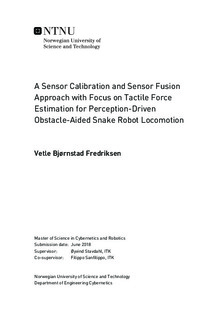A Sensor Calibration and Sensor Fusion Approach with Focus on Tactile Force Estimation for Perception-Driven Obstacle-Aided Snake Robot Locomotion
Master thesis
Permanent lenke
http://hdl.handle.net/11250/2561330Utgivelsesdato
2018Metadata
Vis full innførselSamlinger
Sammendrag
Snake robots have been a research topic of interest since Shigeo Hirose developed the first snake robot in 1972. As with many other types of robots, snake robots are interesting because they could be used to perform tasks too difficult or too dangerous for humans. The idea to design robots similar to snakes comes from what is observed in nature. Real snakes can be seen to navigate through narrow spaces, up steep slopes, and over and around obstacles with ease. They can do this because of their ability to shape their bodies to fit the environment, and through contractions and extensions of muscles, move forward. This is one of the abilities the research community tries to mimic with snake robots - the ability to use the properties of the terrain to its own advantage. In areas where wheeled robots might get stuck, a snake robot could potentially move around easily. When research on snake robots reach the point where their agility reaches a similar level as for real snakes, one can imagine a whole range of scenarios where snake robots are applicable. Inspection of a narrow pipe, mapping of a collapsed building, mine sweeping, and search and rescue operations are all tasks that, in the future, could be performed by snake robots. However, before this can happen, snake robots have to be able to traverse a cumbersome terrain. The technique where a robot uses obstacles to its advantage, rather than being hindered by them, is called obstacle-aided locomotion, and is actively being researched. To achieve obstacle-aided locomotion, the snake is dependent on receiving data from various sensorsto obtain information about the environment. This thesis demonstrates how perception-driven obstacle-aided locomotion is implemented for a real snake robot, in a controlled laboratory environment. The main contributions of this thesis are finalising the calibration of the force detecting sensors, enabling tactile perception implementing sensor fusion, combining tactile perception with visual perception replicating simulation demos with the real snake robot, demonstrating perception-driven obstacle-aided locomotion distributing developed code to be used freely by anyoneThe use of sensor fusion between tactile and visual perception is a big part of achieving perception-driven obstacle-aided locomotion. At the current stage, the snake robot is confined to an indoor laboratory environment, and there is a long way to make snake robots useful in real operations. However, the implementation of perception-driven obstacle-aided locomotion in a laboratory setting is one step along the way.
